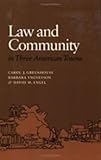Law and Community in Three American Towns / Barbara Yngvesson, Carol J. Greenhouse, David M. Engel.
Material type: TextPublisher: Ithaca, NY : Cornell University Press, [2018]Copyright date: ©1994Description: 1 online resource (240 p.)Content type:
TextPublisher: Ithaca, NY : Cornell University Press, [2018]Copyright date: ©1994Description: 1 online resource (240 p.)Content type: - 9781501725012
- 340/.115 22
- KF371 .G74 1994eb
- online - DeGruyter
| Item type | Current library | Call number | URL | Status | Notes | Barcode | |
|---|---|---|---|---|---|---|---|
 eBook
eBook
|
Biblioteca "Angelicum" Pont. Univ. S.Tommaso d'Aquino Nuvola online | online - DeGruyter (Browse shelf(Opens below)) | Online access | Not for loan (Accesso limitato) | Accesso per gli utenti autorizzati / Access for authorized users | (dgr)9781501725012 |
Frontmatter -- Contents -- Acknowledgments -- Introduction: Ethnographic Issues -- PART ONE. Ethnographic Studies -- Chapter 1. The Oven Bird's Song: Insiders, Outsiders, and Personal Injuries in an American Community -- Chapter 2. Making Law at the Doorway: The Clerk, the Court, and the Construction of Community in a New England Town -- Chapter 3. Courting Difference: Issues of Interpretation and Comparison in the Study of Legal Ideologies -- PART TWO. Law, Values, and the Discourse of Community -- Chapter 4. Avoidance and Involvement -- Chapter 5. Connection and Separation -- Chapter 6. History and Place -- Conclusion: The Paradox of Community -- Notes -- References -- Index
restricted access online access with authorization star
http://purl.org/coar/access_right/c_16ec
Many commentators on the contemporary United States believe that current rates of litigation are a sign of decay in the nation’s social fabric. Law and Community in Three American Towns explores how ordinary people in three towns—located in New England, the Midwest, and the South—view the law, courts, litigants, and social order.Carol J. Greenhouse, Barbara Yngvesson, and David M. Engel analyze attitudes toward law and law users as a way of commentating on major American myths and ongoing changes in American society. They show that residents of "Riverside," "Sander County," and "Hopewell" interpret litigation as a sign of social decline, but they also value law as a symbol of their local way of life. The book focuses on this ambivalence and relates it to the deeply-felt tensions express between "community" and "rights" as rival bases of society.The authors, two anthropologists and a lawyer, each with an understanding of a particular region, were surprised to discover that such different locales produced parallel findings. They undertook a comparative project to find out why ambivalence toward the law and law use should be such a common refrain. The answer, they believe, turns out to be less a matter of local traditions than of the ways that people perceive the patterns of their lives as being vulnerable to external forces of change.
Mode of access: Internet via World Wide Web.
In English.
Description based on online resource; title from PDF title page (publisher's Web site, viewed 26. Apr 2024)


